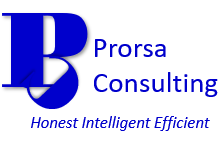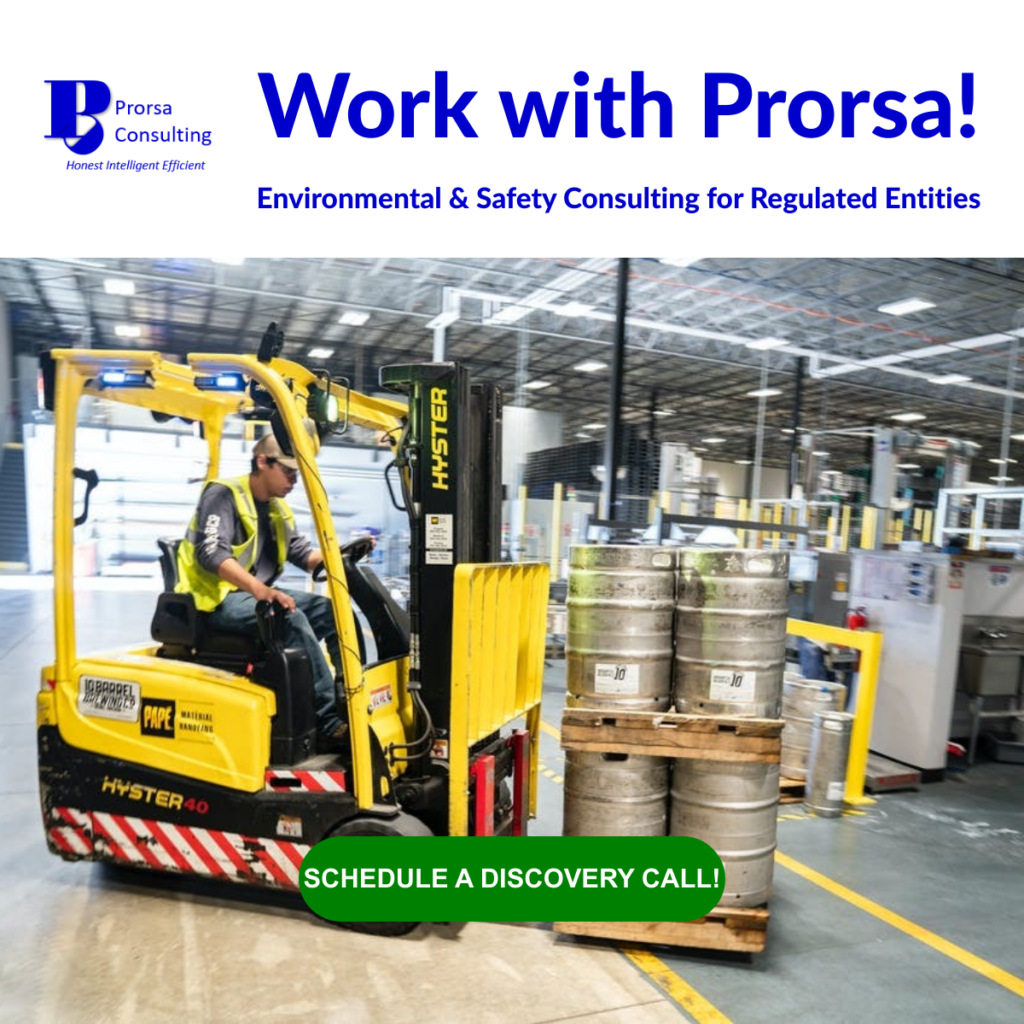Shielding Success: The Vital Role of EHS in Small Business Operations
By : Admin -

When you ignore EHS in small business, it has consequences.
Imagine this scenario . . . You have poured your heart and soul into building your small business. Your dream is flourishing, orders are rolling in, and your brand is gaining recognition. But then, out of nowhere, a workplace incident occurs, leaving one of your employees injured. Soon after, the health and safety regulator knocks on your door, demanding answers, and suddenly, your hard-earned success is at risk. This sobering situation is an unfortunate reality for too many small business owners. It underscores a truth we often overlook – the critical role of EHS in small business survival and prosperity.
EHS, short for Environment, Health, and Safety, isn’t just a corporate buzzword reserved for big corporations. It provides a shield that safeguards your small business against unforeseen disasters, legal troubles, and reputational damage. EHS in small businesses isn’t merely about compliance; it’s about nurturing a culture of safety and sustainability that bolsters your bottom line.
Over the next few minutes, we’ll explore the intricacies of weaving environment, health, and safety into small business management. You will be provided a roadmap to help you shield your success and continue to thrive in a competitive landscape. So, let’s embark on this journey to understand how EHS can be among your greatest allies in pursuing small business viability.
Understanding EHS in Small Business
Defining EHS and Its Components
In small businesses, EHS is a holistic approach to managing the well-being of your employees, the environment, and compliance with environmental, health, and safety regulations. Fulfilling your EHS obligations protects your business from potential legal and financial repercussions. Now, let’s break down each component of EHS.
The environment part of EHS pertains to how your business interacts with and impacts the surrounding ecosystem. Responsible pollution prevention, resource management, waste reduction, and sustainable practices are involved. Certain small enterprises may have an extensive list of very stringent environmental requirements. The level of compliance complexity will depend on the materials utilized, the wastes/byproducts generated, and the activities performed at a facility.
The ‘H’ in EHS emphasizes your workforce’s physical and mental well-being. This component includes everything from ensuring a workplace with minimal toxic exposure risk to promoting a culture of wellness among employees. On the regulatory front, the business must address workplace conditions that may cause health hazards. These conditions may result in acute or long-term effects on workers.
Safety measures provide the foundational third leg of the EHS trio. They encompass various precautions, including hazard communication for chemicals, emergency preparedness, proper machinery operation, working at heights, general housekeeping, electrical safeguards, and many others. A robust safety program prevents incidents and injuries.
EHS in Small Business: Challenges and Considerations
Implementing EHS in a small business setting comes with its unique challenges. Limited resources, tight budgets, and a smaller workforce can make EHS seem daunting, but it’s not insurmountable. We will discuss some key obstacles and considerations in the next few moments.
Lack of Resources
Small businesses often lack the financial muscle of more prominent corporations, leaving them with scarce resources to execute EHS well. Balancing environment, health, and safety initiatives with budget constraints is crucial. However, investing wisely in EHS in small business can lead to long-term cost savings and risk reduction.
Complicated Regulations and Little to No Expertise
Navigating the complex labyrinth of regulations can be overwhelming for small business owners. Furthermore, a lack of in-house expertise can quickly leave businesses confused, frustrated, and at a loss of where to start. Smaller enterprises must learn to cultivate a solid understanding of requirements in-house or rely on external resources to ensure mandates are met. Remember . . . Compliance isn’t just a legal requirement; it’s a shield against penalties and reputational damage.
Crushing Documentation
Last but not least, the documentation and recordkeeping associated with EHS compliance can sometimes be exhausting. However, proper organization and data management tools can assist in streamlining these tasks for small enterprises to keep operations running efficiently.

Image by Gene Gallin on Unsplash.com.
The Business Case for EHS in Small Companies
The Benefits of EHS for Smaller Enterprises
The need for EHS in small business may seem trivial to some, but the rewards far outweigh the efforts. Let’s spend some time exploring the tangible and intangible benefits EHS brings to the table.
Tangible Benefits of EHS in Small Business
The tangible benefits of EHS include risk reduction, cost savings, and increased regulatory compliance. A strong EHS program or management system helps mitigate adverse environmental events and workplace incidents, which, in turn, minimizes the chances of costly lawsuits, fines, and compensation claims. For example, the National Safety Council reported that each medically consulted workplace injury cost $42,000 in 2021. So, EHS risk reduction directly translates into financial stability.
Small businesses can significantly reduce operational costs through EHS measures. Think about what you could do with the resources freed by lower insurance premiums due to improved safety records or decreased raw material purchases through better operational efficiency.
Moreover, compliance with environmental, health, and safety regulations is non-negotiable. EHS ensures your small business adheres to current laws, decreasing the risk of legal penalties and the associated financial strain.
Intangible Benefits of Environment, Health, and Safety Initiatives
The intangible benefits of excellent environment, health, and safety management include an enhanced business reputation and improved employee morale. According to the PwC 2021 Global Investor Survey, 79% of those surveyed agree that Environmental, Social, and Governance (ESG) risks are important when considering investment decisions. As such, small businesses with outstanding EHS track records tend to attract customers, partners, and investors who value responsible business practices, opening the door to new opportunities.
Additionally, employees are more likely to be engaged, productive, and loyal when they see their well-being is prioritized. This positive work environment can reduce turnover, lowering recruitment and training costs.
Examples of What Small Businesses May Face When EHS Management Fails
Warehousing No More (The National Institute for Occupational Safety and Health)
In May 2022, a 39-year-old male retail warehouse worker was killed when cases of water fell off a pallet and struck him. The worker was standing behind the pallet, out of the view of the forklift operator trying to reposition the load. The cased water broke loose from the shrink wrap securing it when shifting occurred. Paramedics were unable to revive the worker.
The inexperience of the worker, failure to follow procedures, the victim’s intoxication, and a lack of first aid/CPR training all contributed to the fatal incident. The employer’s protocols also did not address securing unstable loads on pallets. The Occupational Safety and Health Administration (OSHA) issued penalties of $100,425 in this case.
Simple Reporting Turns Costly (Environmental Protection Agency)
In 2019, a small footwear manufacturer was fined $49,625 by the Environmental Protection Agency (EPA) for failure to report information about its hazardous chemicals to the State Emergency Response Commission (SERC), Local Emergency Planning Committee (LEPC), and local fire department. Additionally, the business failed to complete its Toxic Release Inventory (TRI) reporting to the EPA.
How would your small business operation fare in the face of significant fines like these?
EHS Compliance in Small Business Management
Navigating EHS Regulations in Small Businesses
Regarding EHS (Environment, Health, and Safety) compliance in small business management, understanding the regulatory landscape is paramount. Small businesses operate in diverse sectors carrying unique sets of compliance requirements.
The first step in traversing these standards is correctly identifying all EHS legal requirements. Small businesses should start with any permits issued to them by regulatory agencies. These documents will detail the necessary steps to maintain compliance.
Next, small enterprises should delve into the regulations and codes themselves. In most cases, the rule or standard will have an applicability section, spelling out the specific conditions, activities, and/or industries the regulation covers. Additionally, don’t forget to review federal, state, and local codes that may apply to your small business operation.
Regulatory agencies will often also publish policy and guidance documents to explain and further clarify the interpretation and enforcement of the rules under their jurisdiction. This information may aid in a small company’s understanding of its legal obligations.
By law, all employers in the U.S. must provide a workplace free from recognized safety and health hazards. Furthermore, health and safety hazard assessments are considered standard best practice to identify potentially dangerous conditions or actions at an establishment.
These evaluations require comprehensive reviews of the facility and its materials and processes to detect hazards. After identifying the hazardous items, a risk rating should be assigned to each based on the likelihood of exposure to the hazard and the severity of the consequences. The final risk rankings will assist in prioritizing hazards for mitigation, allowing to focus on high-impact areas for increased cost-effectiveness.
Strategies for Wrangling EHS Regulations in Small Enterprises
Even while grappling with limited resources and lacking in-house expertise, attaining compliance and the benefits of exemplary EHS in small business is possible. Companies stand a better chance of success when strategies and resources like the ones below are employed to streamline the process.
Leverage Online Resources
Explore online platforms and resources provided by government agencies. For example, the OSHA and EPA offer guidance tailored to small businesses. These resources provide templates, checklists, and information to simplify compliance efforts. They also possess compliance assistance programs aimed at smaller enterprises.
Seek Professional Guidance
Consider partnering with EHS consultants or professionals who specialize in small business needs. They can provide expert advice, conduct assessments, and assist in developing compliance strategies that align with your business’s size and industry.
Develop a Compliance Calendar
Create a compliance calendar to track important deadlines and requirements. This proactive approach ensures your business stays ahead of regulatory changes and avoids last-minute rushes to meet deadlines. As a best practice, companies should utilize digital tools that provide automatic notifications to facilitate on-time task completion.
Integrating EHS into Small Operations
Effective Incorporation of Environment, Health, and Safety Principles
Integrating EHS values into the daily operations of small businesses requires a strategic approach that ensures environmentally friendly practices and a commitment to employee safety and well-being. Top leadership, supervisors, and employees all play critical roles in engraining environment, health, and safety in the company’s normal business functioning.
Develop Solid Policies and Procedures
Instilling EHS in small business begins with developing clear policies and procedures. To execute, start with the regulatory reviews and risk evaluations described in the last section. This action will help the business determine the areas, activities, and topics to be addressed. Furthermore, procedural documents should be tailored to meet the operation’s needs and be available for employees to access readily. Policies and procedures must be reviewed periodically and updated to align with regulatory changes.
Likewise, an internal reporting strategy for environment, health, and safety should be defined. The company’s chosen scheme must encourage employees to promptly report environment, health, and safety concerns and incidents. Implementing an open and transparent reporting system allows for quick resolution to issues and helps maintain a compliant workplace.
Identify Appropriate Roles and Responsibilities
Every robust EHS program designates the roles and responsibilities of individuals participating in the facility’s efforts. When designing documentation for EHS in small business, an EHS coordinator, officer, or team should be identified as responsible for the day-to-day administration of initiatives. Moreover, other responsibilities such as setting policy and vision, allocating resources, program enforcement, and corrective action execution should be assigned as appropriate to fit the company’s management structure.
Invest in Robust Employee Training
In addition, worker training provides the foundation for employees to integrate EHS into the business’s operations successfully. The company must ensure individuals are aware of environment, health, and safety protocols. Additionally, workers need proper instruction covering the equipment required to execute the program. Ongoing EHS education is essential to keep employees informed and prepared.
Creating a Positive Culture of EHS in Small Business
Building a constructive EHS culture within your operation is more than just following rules; it’s about fostering a mindset of shared values around the small business management of EHS. Additionally, nurturing a solid philosophy within the workforce cultivates ongoing integration of EHS at all levels of the organization.
Lead by Example, Displaying Strong Commitment to EHS Compliance
Leadership sets the tone for EHS in small business. Consequently, leaders must deliberately demonstrate commitment to EHS principles by allocating resources, participating in safety programs, and communicating the importance of EHS throughout the organization. Leaders should also lead by example. Making EHS a priority in top leadership’s actions and decisions creates an environment where employees are more likely to embrace initiatives.
Promote Employee Engagement and Participation as Part of Your Small Business Management for EHS
Moreover, small businesses must engage employees in the EHS process. Employee involvement enhances EHS performance and fosters a sense of ownership and responsibility. So, encourage workers to report safety concerns, provide feedback on EHS measures, and participate in committees.
Communicate Openly and Regularly
Compliance management also thrives in a workforce with open and transparent communication about environment, health, and safety matters. Therefore, encourage workers to report concerns without fear of reprisal and regularly communicate EHS updates and challenges.
Recognize and Reward
Small companies can also reinforce the importance of EHS through recognition. As such, organizations should acknowledge and appropriately reward individuals who commit to workplace EHS efforts. Doing so will continue motivating employees to engage and participate.
Continuously Improve Compliance Efforts
Last but not least, continuous improvement serves as the engine to better success. Thus, small businesses should prioritize addressing employee concerns, correcting non-compliant conditions, and identifying ways to enhance their existing EHS measures.
Practical Solutions for Overcoming Challenges in Small Enterprises
Resource Limitations: Prioritizing EHS Investments
Small businesses often operate on constricted budgets, making it crucial to allocate resources wisely. Implementing a phased approach to EHS in small business will allow you to make smaller but intelligent choices now that will grow into future wins. Begin with the most critical areas and gradually expand as resources become available.
This incremental approach ensures steady progress without straining your budget. Moreover, it allows the workforce to adjust to changes and have time to build a solid foundation for your EHS efforts.
Lack of Expertise: Building In-House Competence
EHS compliance requires specialized knowledge, which may be lacking in small business settings. To overcome this obstacle, identify and train key personnel within your organization to take on environment, health, and safety responsibilities. Thus, the company will have an in-house employee with the knowledge and certifications to help streamline efforts.
Furthermore, small enterprises can partner with consultants or professionals specializing in small business needs. Their expertise can fill the experience gap and provide tailored guidance on compliance, EHS measures, and risk evaluations.
Compliance Complexity: Staying Informed on EHS in Small Business
Staying up to date with constantly evolving EHS regulations is vital to compliance. Therefore, small companies should subscribe to industry newsletters, attend webinars, and join relevant agency listservs. These resources provide timely updates on regulatory changes specific to your sector, helping you stay informed without overwhelming your team.
Likewise, small enterprises may join the local chamber of commerce or industry-specific associations. These organizations often offer support for environment, health, and safety programs, including access to compliance resources and experts.
Recordkeeping: Streamlining Environment, Health, and Safety Data Management
Maintaining accurate records is often required to demonstrate compliance and facilitate agency reporting. Small businesses can overcome this hurdle by investing in digital recordkeeping systems that streamline data management. Digital systems are more efficient and reduce the risk of errors associated with manual recordkeeping.
Additionally, you will want to ensure your data are easily accessible. Records should be well organized and quickly available for audits, inspections, or reference. To meet the challenge, consider implementing a structured filing system that allows for simple retrieval of necessary documentation.
More EHS in Small Business Articles for You
Top Management Commitment in EHS: The Surprise Defense to a Deficient Culture
Worker Participation in Safety Management: Strategies to Boost Engagement
EHS Compliance Benefits to Know and Always Welcome in Your Operations
Final Thoughts on Prioritizing EHS in Small Business for Success
In this comprehensive exploration of environment, health, and safety in the context of small businesses, we’ve delved into its crucial role for operational and financial continuity. By understanding EHS in small business and addressing the challenges faced by implementing practical solutions, smaller enterprises reap cost savings, reputation enhancement, and a competitive edge.
Small business owners, general managers, and EHS professionals should prioritize the integration of environment, health, and safety into daily operations. Not doing so is simply bad for business. So, take proactive steps, leverage available resources, and commit to continuous improvement. Remember, EHS in small business is not only an obligation; it’s also an opportunity to safeguard your business, your employees, and your legacy.
We encourage your feedback on this blog. Please like, comment, and share this content if you find it helpful. You can also provide us with feedback via our Contact Us page.
Don’t forget to follow Prorsa Consulting on LinkedIn, Pinterest, and Twitter.
Prorsa Consulting supports regulated businesses in their efforts to assess, maintain, and improve environmental and safety compliance. Schedule a discovery call with us today If you are ready to lower the risk of costly environmental, health, and safety penalties, enhance performance, and build a more favorable business reputation.
How would you like access to additional, exclusive EHS updates & info from Prorsa Consulting? Just sign up for the Prorsa Consulting Newsletter below. You’ll gain entrance to our Free Resources area and the ability to use all the library’s tools, templates, and presentations. There’s no cost, and you can cancel at any time. So, strike while the iron is hot!






